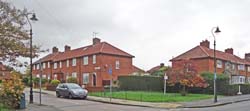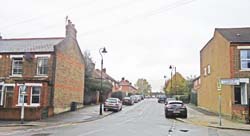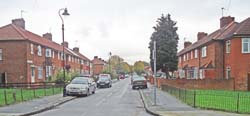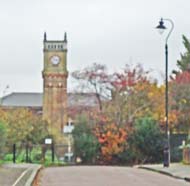King
Albert's Hospital for Convalescent Belgian Soldiers
No. 2
No. 2
Park School, Framfield Road,
Hanwell, Middlesex W7
Medical
dates:
Medical
character:
Convalescent (military)
The second King Albert's
Hospital opened on 7th January 1915, just over a month after the
first
one.
The Hospital, which had 310 beds, occupied the premises of Park School, which comprised 23 separate pavilions on an 11-acre site. The single-storey buildings were made from wood and corrugated iron. As well as dormitories, the site contained other detached blocks for the kitchens, two dining halls, school rooms, mess rooms, Matron's quarters and nurses' bedrooms.
Wounded and convalescent soldiers were accommodated in 11 of the pavilions, each of which held 36 beds and a small bedroom for the sub-officer in charge. One pavilion served as an infirmary and a second one as an isolation ward in case of infectious or contagious disease. A third was made into a Recreation Hall. Meals were taken in the two dining halls.
Another pavilion was turned into a chapel. On 30th March 1915 the military chaplain assigned to the Hospital blessed it and dedicated it to St Albert. On Sundays two Masses were held, and one Mass on other days.
The Captain-Commander had his office in a pavilion which also contained the Account Unit, the clothing stores and the maintenance workshop. All the services and the works, with the exception of the laundry, were carried out by the convalescents themselves.
The pavilions were furnished with central heating, gas lighting and a wash house where patients could have hot or cold showers, as they wished.
Medical care was provided by two military physicians. A dentist visited regularly to treat the convalescents. The nursing staff consisted of an English Matron (Miss Richards) and four nurses, one of whom was Belgian. The other personnel comprised 12 administrators and 15 domestics.
On 12th May 1915 the bed complement was increased by an additional 112 beds.
By autumn a canteen had opened where the patients could buy beer, pipe tobacco and Dutch cigars at cost price.
As the number of convalescent soldiers in England had dropped considerably by the end of 1915, the Management Committee decided to close the Hospital on 22nd December 1915. At the time of closure only 9 patients remained.
The buildings were returned to the disposition of the Local Government Board on 31st December 1915.
During the Hospital's operational lifetime, some 1,885 had received treatment. Of these, only one had died, but 23 had deserted.
Present status (November 2013)
The Hospital, which had 310 beds, occupied the premises of Park School, which comprised 23 separate pavilions on an 11-acre site. The single-storey buildings were made from wood and corrugated iron. As well as dormitories, the site contained other detached blocks for the kitchens, two dining halls, school rooms, mess rooms, Matron's quarters and nurses' bedrooms.
Wounded and convalescent soldiers were accommodated in 11 of the pavilions, each of which held 36 beds and a small bedroom for the sub-officer in charge. One pavilion served as an infirmary and a second one as an isolation ward in case of infectious or contagious disease. A third was made into a Recreation Hall. Meals were taken in the two dining halls.
Another pavilion was turned into a chapel. On 30th March 1915 the military chaplain assigned to the Hospital blessed it and dedicated it to St Albert. On Sundays two Masses were held, and one Mass on other days.
The Captain-Commander had his office in a pavilion which also contained the Account Unit, the clothing stores and the maintenance workshop. All the services and the works, with the exception of the laundry, were carried out by the convalescents themselves.
The pavilions were furnished with central heating, gas lighting and a wash house where patients could have hot or cold showers, as they wished.
Medical care was provided by two military physicians. A dentist visited regularly to treat the convalescents. The nursing staff consisted of an English Matron (Miss Richards) and four nurses, one of whom was Belgian. The other personnel comprised 12 administrators and 15 domestics.
On 12th May 1915 the bed complement was increased by an additional 112 beds.
By autumn a canteen had opened where the patients could buy beer, pipe tobacco and Dutch cigars at cost price.
As the number of convalescent soldiers in England had dropped considerably by the end of 1915, the Management Committee decided to close the Hospital on 22nd December 1915. At the time of closure only 9 patients remained.
The buildings were returned to the disposition of the Local Government Board on 31st December 1915.
During the Hospital's operational lifetime, some 1,885 had received treatment. Of these, only one had died, but 23 had deserted.
Present status (November 2013)
Park School had originally started life as the Ophthalmic Institute, built as an extension to the Central London District Schools. Following the abolition of the Boards of Guardians in 1929, the School came under the control of the LCC, who renamed it the Hanwell Residential School.
After WW2 the Schools were demolished and replaced by housing on Homefarm Road and Stephenson Road.

The corner of Homefarm Road and Littlejohn Road borders the western side of the Hospital site.

Browning Avenue has been built on the eastern part of the site. The northern part of Browning Avenue follows the original driveway to the Hospital.

Stephenson Road (above and below) occupies the central part of the site.


The surviving tower of the Central London District Schools. Park School was built to the southeast of it.
(Author unstated) 1917 Hospitals of the United Kingdom of Great Britain. The Military Surgeon 41, 638.
May P 1915 King Albert's Hospitals. Rapport de l'Exercice 1914-1915 [in French]. Document BEL 10 1/7 Women at Work Collection, Imperial War Museum, London.
Pardoe M 1917 Correspondence giving further information about King Albert's Hospitals. Document BEL 10 1/4 Women at Work Collection, Imperial War Museum, London.
www.1914-1918.be
www.rootschat.com
Return to alphabetical list
Return to home page